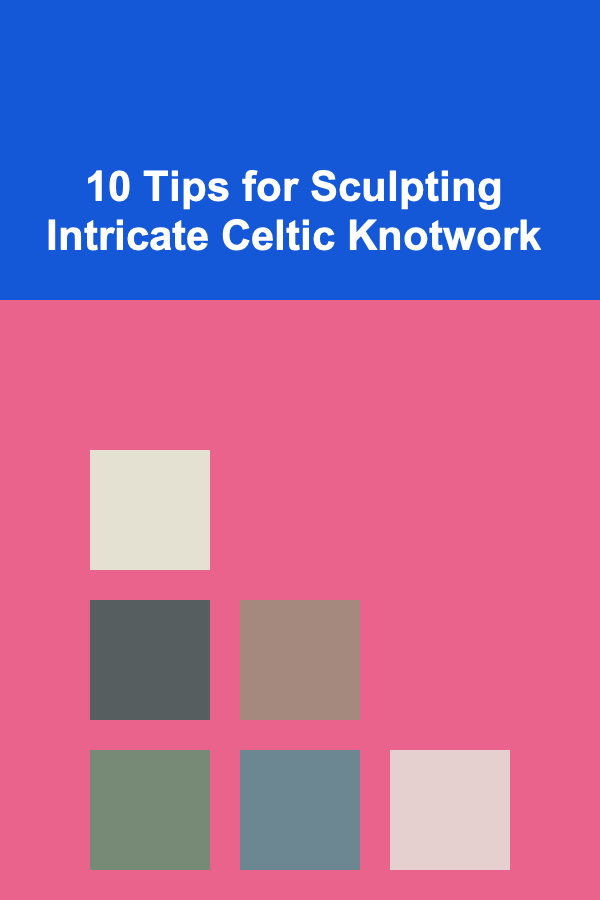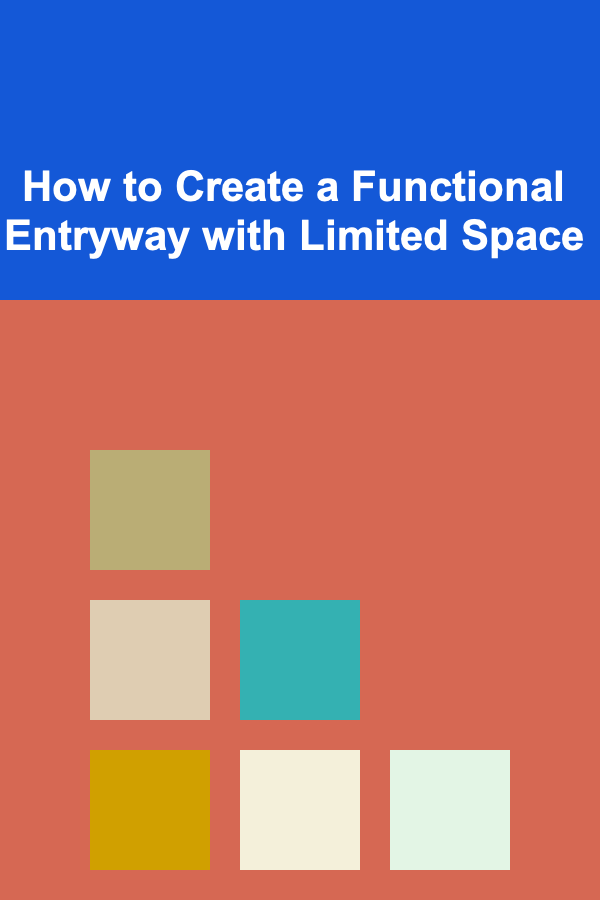
10 Tips for Sculpting Intricate Celtic Knotwork
ebook include PDF & Audio bundle (Micro Guide)
$12.99$11.99
Limited Time Offer! Order within the next:

Celtic knotwork is a timeless form of art that has been admired for centuries. Its intricate, flowing designs symbolize eternity, interconnectedness, and cycles of life. Whether you're creating Celtic knotwork for a personal project, an artistic piece, or learning it as a hobby, mastering the art of crafting these elaborate patterns requires patience, skill, and an understanding of the essential techniques that bring these knots to life.
Sculpting intricate Celtic knotwork is not just about drawing or carving; it involves understanding the principles behind the designs and using the right tools and methods to create a flawless piece. In this article, we will explore 10 tips that will help you sculpt and master intricate Celtic knotwork, whether you're a beginner or looking to refine your existing skills.
Understand the Basics of Celtic Knotwork
Before you start sculpting or carving, it is essential to have a foundational understanding of Celtic knotwork. Celtic knots are typically made of continuous lines that loop over and under one another without any breaks. The most iconic feature of these designs is their never-ending, interwoven flow, representing the concept of eternity. These loops can be complex, featuring multiple strands, or simple, with only a few interwoven paths. Understanding the fundamental patterns, such as the Trinity knot, the square knot, and the endless knot, will give you a solid foundation for creating intricate designs.
Tip:
Study the classic forms and their symbolic meanings, as these will inspire your creations and give your work deeper significance.
Start with a Simple Design
When you are new to Celtic knotwork, it's tempting to jump straight into intricate designs. However, it's wise to start simple. Begin with basic knots like the single loop, the double knot, or a simple triquetra. These basic shapes will help you build an understanding of how the interwoven lines work, and they provide a manageable starting point for practice. Once you master the basics, you can gradually increase the complexity of your designs.
Tip:
Work on sketching these simple knots on paper first before attempting to carve or sculpt. This will help you perfect the symmetry and flow of the pattern.
Use a Grid or Template
For intricate and symmetrical designs, using a grid or template is invaluable. The grid ensures that your lines and loops are even and proportional, which is key in creating balanced and visually appealing knots. Templates, whether printed or drawn by hand, serve as a guideline to structure your design. You can use software tools to create digital templates or simply draw a grid with a ruler on paper.
Tip:
Once you have a basic design on paper, lightly trace over it with a pencil before carving. This will help you stay within the lines as you move onto more detailed work.
Master the Technique of Interlacing
Interlacing is the heart of Celtic knotwork. It's the art of weaving lines over and under one another in a continuous flow. When carving or sculpting Celtic knots, it's important to maintain consistent, even interlacing. The way the lines cross and loop gives the knot its intricate appearance. Often, interlacing involves one strand appearing to pass under and over others multiple times in a repeating pattern. The challenge here is to keep track of where each line goes while maintaining the integrity of the overall design.
Tip:
To practice interlacing, start with a simple knot and focus on the over-under technique. Use different colors or line thicknesses to differentiate each strand, helping you visualize the flow more clearly.
Pay Attention to Line Thickness
The thickness of the lines in your Celtic knotwork can have a significant impact on the final result. Uniform line thicknesses create a clean and balanced design, but subtle variations in thickness can add depth and dimension to the knot. You can experiment with thicker lines for the main strands and finer lines for the smaller loops and intersections.
When sculpting, it's especially important to keep the depth of each line consistent to avoid uneven texture or breaks in the design.
Tip:
Use a pencil to lightly shade in different sections of your knotwork, indicating where you would like to add thicker or thinner lines, helping you visualize the dimensionality before committing to carving or sculpting.
Incorporate Negative Space
Negative space, the area around and between the lines, is an essential component of intricate Celtic knotwork. By leaving certain spaces open, you can create visual interest and balance within the design. These gaps allow the viewer's eye to rest and appreciate the flow of the knotwork. As you work, consider how negative space can complement the overall design rather than filling in every available area.
Tip:
When planning your knotwork, deliberately plan where the negative space will be. Avoid the temptation to make every strand touch or fill every space to the edges, as this can make the design feel cramped.
Practice Precision with Your Tools
Whether you are drawing, carving, or sculpting, precision is key. With intricate Celtic knotwork, even a small mistake can throw off the entire design. Practice with your tools before starting on your final piece. If you're carving or sculpting, make sure you're comfortable with your chisels, knives, or other tools. If you're drawing, make sure you have sharp pencils or pens and steady your hand before making any cuts.
Tip:
If you're carving into wood, stone, or another material, practice on scrap pieces to get a feel for how the material behaves. Pay attention to how deep your cuts need to be for the desired effect.
Use Symmetry to Your Advantage
Celtic knotwork is known for its symmetrical designs. Symmetry helps maintain harmony and visual balance in the pattern. As you create your knots, be mindful of how the elements of the design mirror each other. If you are drawing, use a ruler or compass to ensure even spacing. If you are sculpting, symmetry can be maintained by flipping your design to match each side.
Tip:
Start by drawing half of the knotwork and then mirror it to complete the design. This will ensure perfect symmetry.
Experiment with Different Materials
Sculpting Celtic knotwork doesn't have to be limited to traditional mediums like stone or wood. Modern tools and materials allow for a wide range of possibilities. You can create Celtic knotwork in clay, metal, or even 3D digital designs. Each material will affect the texture and finish of your knotwork differently, so experiment with a variety of media to find the one that suits your vision.
Tip:
For beginners, start with clay or a soft medium to practice your carving technique. These materials are forgiving and allow you to make adjustments without damaging the work.
Add Details to Enhance the Design
Once you've mastered the basic techniques and created your fundamental design, you can start adding intricate details that will make the knotwork more sophisticated. Small flourishes, patterns, or accents within the lines can elevate your work and make it truly unique. Adding subtle variations in the knot's intersections, or including other traditional Celtic motifs like spirals or leaves, will help enhance the overall effect.
Tip:
Don't rush the detailing process; it's easy to overcomplicate a design. Focus on adding fine details gradually, making sure they enhance the flow of the knotwork rather than overwhelm it.
Conclusion
Sculpting intricate Celtic knotwork is an art form that requires patience, skill, and a deep understanding of the principles behind the designs. By following these tips, you can master the technique and create breathtaking, intricate knots that evoke the beauty and depth of Celtic heritage. Whether you're carving, drawing, or sculpting, remember to start simple, maintain symmetry, and experiment with different materials and tools to find what works best for your style. With practice, you'll find yourself creating designs that reflect the timeless beauty of Celtic art and its deep cultural significance.
Reading More From Our Other Websites
- [Organization Tip 101] How to Keep Your Car Organized When You Have Limited Space
- [Home Security 101] How to Protect Your Home by Disabling Unnecessary Smart Home Features
- [Gardening 101] How to Install and Program Your Garden Irrigation Timer in 5 Easy Steps
- [Rock Climbing Tip 101] Top Must‑Try Routes in Every Climbing Gym: A Seasonal Checklist for Adventurous Climbers
- [Home Cleaning 101] How to Achieve Speed Cleaning Nirvana: Hacks for the Time-Crunched Homemaker
- [Organization Tip 101] How to Use Analytics Tools to Improve Your Workflow
- [Home Budget Decorating 101] How to Redecorate Your Bedroom Using Affordable Accessories
- [Sewing Tip 101] Seasonal Stitch-Work: Sewing Lightweight Summer Dresses and Cozy Winter Sweaters
- [Star Gazing Tip 101] Multi-Sensory Stargazing: How to Engage All Your Senses for a Truly Unique Night-Sky Escape
- [Organization Tip 101] How to Use Labels for Effortless Organization

How to Create a Functional Entryway with Limited Space
Read More
How To Create a 'No Makeup' Makeup Look
Read More
How to Keep Your Home Safe While Working from Home
Read More
How to Make Your Home Safe for Small Pets like Hamsters and Rabbits
Read More
How To Learn Basic Personal Finance Management
Read More
How to Use a Checklist to Prevent Insect Health Problems
Read MoreOther Products

How to Create a Functional Entryway with Limited Space
Read More
How To Create a 'No Makeup' Makeup Look
Read More
How to Keep Your Home Safe While Working from Home
Read More
How to Make Your Home Safe for Small Pets like Hamsters and Rabbits
Read More
How To Learn Basic Personal Finance Management
Read More